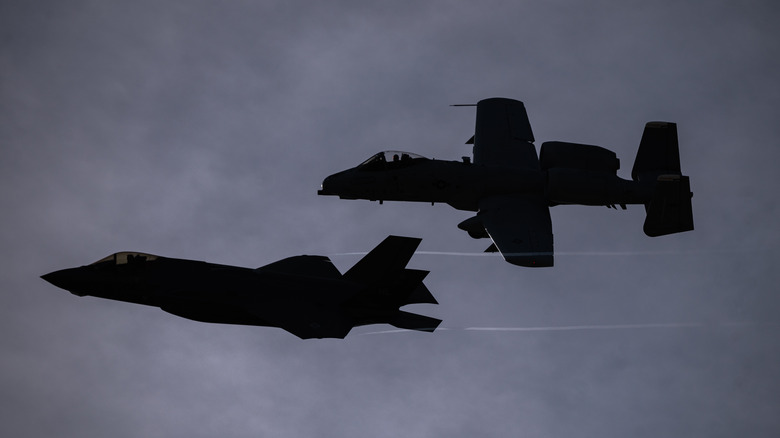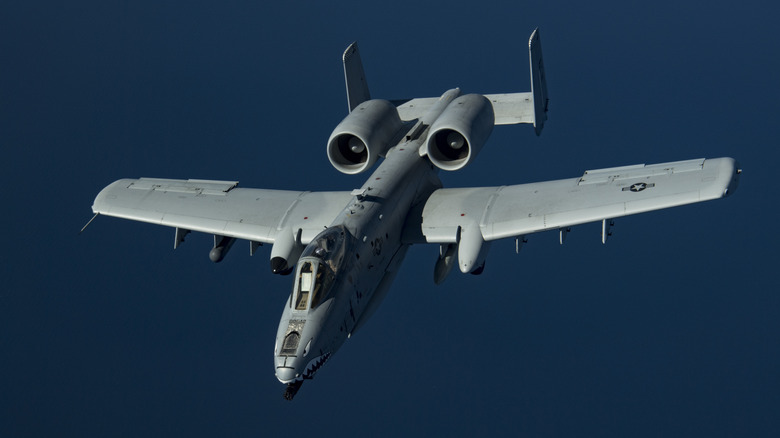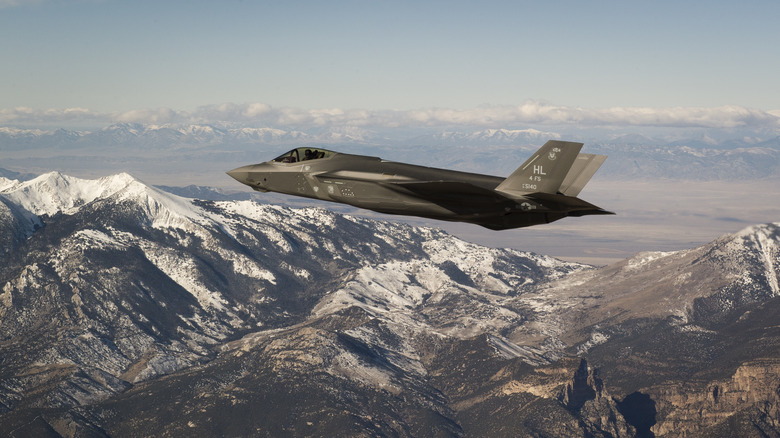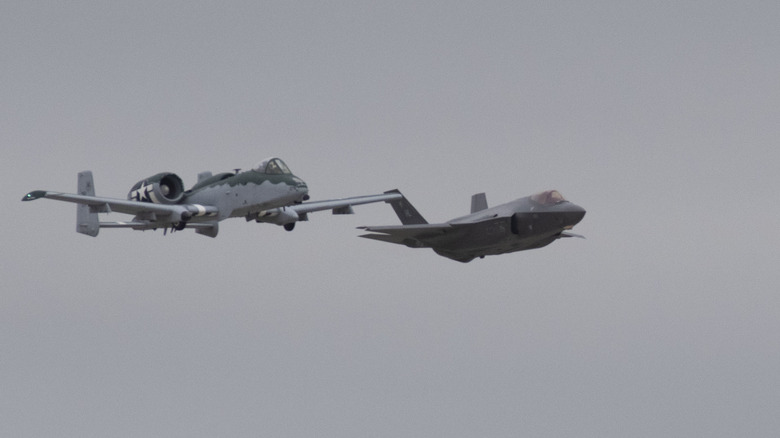F-35 Lightning II Vs A-10 Warthog: Which Is The Better Close-Air Support Aircraft?
Ever since the Joint Strike Fighter program took flight in 2001, the U.S. Air Force hasn't been quiet about what it wants out of the expensive fifth-generation aircraft: to have the F-35 Lightning II serve as a true multirole platform, eventually replacing the F-16 Fighting Falcon in most air-to-air combat roles, as well as succeeding the A-10 Thunderbolt II – affectionately dubbed the "Warthog" — in air-to-ground operations.
The logic behind the decision was sound: swapping out two aircraft for one means a huge reduction in cost and a shorter logistic tail. The Air Force had considered mothballing the Warthogs as far back as 1991, but the plan never materialized out of the sheer amount of flak from policymakers in the halls of Congress every time it was brought up. In service since the 1970s, the Warthog has stuck by troops through the Gulf Wars and most conflicts in the Middle East, with the iconic growl of its GAU-8 Avenger cannon as it tore in to provide Close-Air Support (CAS) a legend among troops.
So, the Warthog is still flying for now, but the Air Force hasn't given up its plan to retire the plane. To bolster its case, the service has been pitching the two platforms against one another in exercises for years. We took a brief look at the process through a heavily redacted test report obtained by the Project on Government Oversight (POGO) in 2023. It poses only one question: Which is the superior CAS aircraft?
The Hog of War
Even from the drafting table, the A-10 Thunderbolt II was envisioned to be the best CAS aircraft that the Air Force could get its hands on at the time. The research program that eventually conceived the A-10 — the Attack-Experimental (A-X) program started in 1966 – required every design proposal to include a 30mm rotary cannon to defeat Soviet tanks. The winner of this competition was Fairchild Republic, with its Y-10A prototype, later re-designated the A-10, and that cannon was later designated the GAU-8 Avenger.
In addition to its armor-defeating 3,900-rounds-per-minute cannon, the A-10 can carry 16,000 pounds of mixed ordnance across 11 hardpoints studded under the wings and fuselage. The A-10 is propelled by a pair of General Electric TF34-GE-100 turbofans that are uniquely mounted high above the tail to avoid ingesting debris when operating from basic airfields with short, unpaved runways.
Since a ground attack has little need for supersonic speed, the A-10 cruises quite slowly at around 360 knots, which makes it extremely vulnerable to anti-air fire. To make it more survivable, the aircraft is designed with redundant flight systems and, notably, a titanium "bathtub" built around the pilot to protect them from small-arms fire and fragments from exploding munitions. Its durability, combined with its fearsome firepower, has made the A-10 a commander's favorite for CAS missions since its maiden flight in environments without much anti-aircraft fire.
Where the F-35 Fits In
The F-35 Lightning II is a multirole fighter, meaning it can handle a wide range of missions, from air interdiction to CAS. For the latter task in particular, the Air Force-specific variant, the F-35A, has a 25mm GAU-22/A rotary cannon built right into the airframe. It's of lower caliber and doesn't have as expansive a magazine as the A-10's GAU-8, but this means the F-35 is still capable of performing strafing runs like the Warthog — albeit limited by its meager 181 rounds of ammunition. The F-35 can also be integrated with newer guided missiles and bombs, like AGM-158 JASSM and AGM-179 JAGM that the A-10 isn't provisioned to carry.
The Air Force's argument for the F-35 centers around its speed, stealth capabilities, and advanced sensors. By concealing its weapons in an internal bomb bay, the F-35 can penetrate an enemy's integrated air defense systems (IADS) in high-intensity conflicts, allowing for safer and more effective munition delivery. In contrast, the A-10's slow speed, lack of stealth, and absence of sensors (it doesn't even have radar!) make it a tough option to pick in high-threat environments.
However, in low-threat scenarios, the F-35 can sacrifice some of its stealth capabilities to carry more weapons using wing-mounted pylons. This configuration allows the F-35 to expand its payload from a modest 5,700 pounds (when using only internal weapons) to an impressive 18,000 pounds or more. In any case, it's undeniable that the F-35 is a respectable CAS platform.
What's the verdict, per the Air Force?
The POGO-obtained test report, despite its heavy redactions and missing crucial data points, revealed the F-35's lackluster performance compared to the A-10. One notable issue was the F-35's need for more sorties to attack the same number of targets as the A-10, largely due to its smaller "typical" payload when relying solely on its internal bomb bay without wing-mounted pylons.
To illustrate, a decked-out A-10 can carry 16 GBU-39 small-diameter bombs at once, while the F-35 is limited to just eight. Moreover, the F-35's GAU-22/A gun, with its smaller magazine (181 rounds versus the A-10's 1,350) and notorious accuracy issues (only recently addressed in March), was such a glaring problem point that the report's executive summary recommended point-blank that the F-35 Joint Program Office "fix the F-35A gun."
Although the test was marred by various issues, ranging from poor communication and faulty navigation to the absence of ground troops, the report concluded on a positive note for the F-35, acknowledging its superior performance in high-threat environments — a scenario the A-10 was not designed to handle. So, the F-35 is evolving into a viable replacement for the A-10, particularly in conditions with dense air defense systems — like those encountered in Ukraine — where it could potentially outperform the low-and-slow Warthog. However, the question remains: does this advantage justify the complete replacement of the A-10? The answer's still a work in progress for the Air Force.



